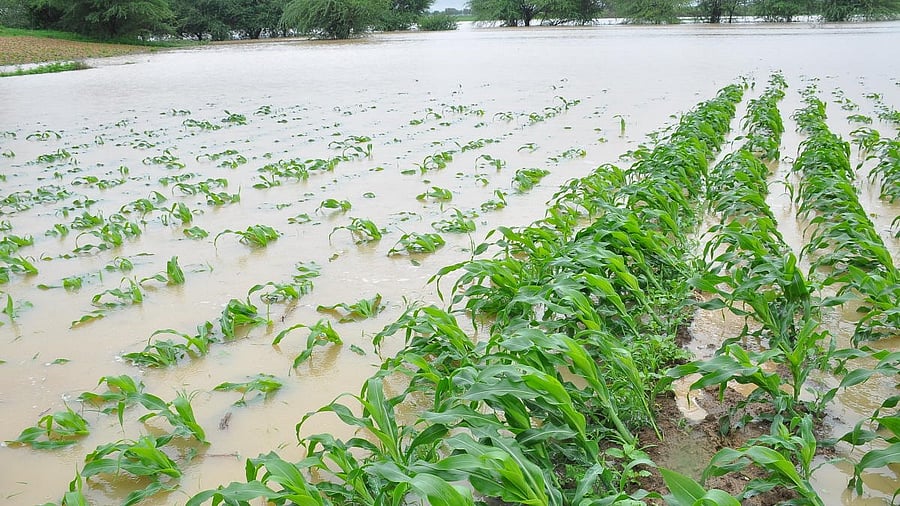
Hubballi: For the last two years, North Interior Karnataka (NIK) region has witnessed higher rainfall days compared to South Interior Karnataka (SIK).
NIK, in 2025 and 2024, reported 102 and 108 rainfall days, whereas SIK recorded 89 and 97 rain days, respectively.
The coastal and Malnad regions clocked their average rainfall of around 160 days this year.
Officials in India Meteorological Department record one rainfall day if a weather monitoring station registers more than 2.5 mm of rainfall in 24 hours.
The Karnataka State Natural Disaster Monitoring Centre (KSNMDC) has over 6,500 telemetric rain gauges, 850 telemetric weather stations and 14 seismic stations in the state to monitor weather.
The higher number of rainfall days has adversely impacted dry-agriculture crops of north Karnataka region, especially tur, green gram and maize.
Data from the agriculture department shows crops on nearly 13.65 lakh hectares were affected this monsoon and nearly 70% of that was recorded in the districts of Kalaburagi, Yadgir, Vijaypur, Gadag, Bagalkot, Bidar and Dharwad.
The excess rain will not only increase the cost of cultivation for farmers but, will also increase food inflation.
With 149 rain days, 2025 was Karnataka’s third wettest year in the last 5 years.
Data shows that in the last six years, the state has reported five high rainfall years.
Multiple factors, including climate change and wind pattern, are being cited for the increasing rainfall days in north Karnataka.
“Monsoon arrived in Karnataka much before its usual first week of June. Rains have continued till October. In a normal rainfall year, the state used to record 65-70 days of rainfall. However, this year, it has been higher in all four regions,” says N Puviarasan, head, Bengaluru Meteorological Centre.
NIK witnessed more rainfall because the south west monsoon trough axis was south of its normal position. The monsoon depression or low developed in head bay was moving along the monsoon trough giving more rainfall over NIK than SIK, he says.
The farmers of north Karnataka region are not just affected by flooded fields, but also diseases caused by excess rainfall. Tur, one of the staple crops of the seven districts of NIK, is affected by phytophthora stem blight, macrophomina blight and dry root rot diseases.
“Since 2021, NIK is witnessing an intense and prolonged rainy season. A region that used to receive 400 mm of annual rainfall is getting over 900 mm of rainfall in just two-three months, resulting in damage to crops and disease spread,” says Mallikarjun Kenganal, senior scientist (plant pathology).
He says the excess rain is also resulting in leaching out of soil content of fields, forcing farmers to shell out more on cultivating crops.
“The long duration of rains has also adversely impacted crop growth. Tur, which had to flower by now and get harvested by December, is still in vegetative stage. He says the state could witness at least 50% lower yield of tur this year.
Karnataka cultivates kharif crops on 81.22 lakh ha, out of which over 13.65 lakh ha has sustained losses.
Tur, cultivated on nearly 5.36 lakh ha, has been damaged, followed by cotton on 2.68 lakh ha, green gram on 2.63 lakh ha, maize on 1.21 lakh ha and soybean on 97,810 ha.
Flooding of Bhima and Krishna rivers in September and October resulted in 3.24 lakh ha of standing crops being damaged in Kalaburagi district, followed by Vijayapura (3.14 lakh ha), Bidar (16.54 lakh ha), Yadgir (1.42 lakh ha), Gadag (1.21 lakh ha), Dharwad 93,230 ha and Belagavi 84,203 ha.
Thimmegowda M N, agro-metrologist at University of Agriculture Sciences (UAS), Bengaluru, says although the state witnessed 20% to 40% excess rainfall days this year, its distribution was not even across the state and duration.
“There were long periods of rain-free dry spells. Yet, the cultivation of foodgrains will not be impacted in SIK as the previous year’s excess rain supported groundwater this year and resulted in maintaining soil moisture,” he says.
He predicts that while pulses in NIK region may face temporary setback during kharif season, rabi could witness bumper yield, if weather pattern is good.
Thimmegowda says SIK is better placed as the reservoirs are almost filled and there was no flooding in any districts.
Prolonged rains in the state could also impact the production of areca and coconut as they too are vulnerable to disease, Kenganal said.
